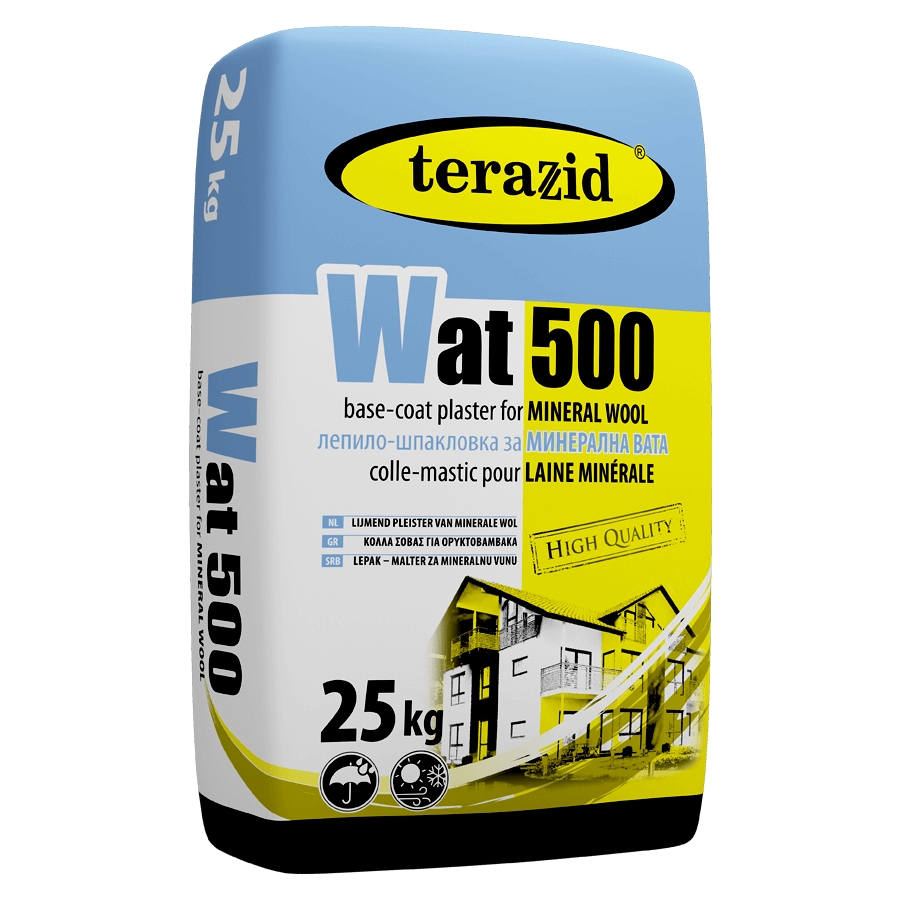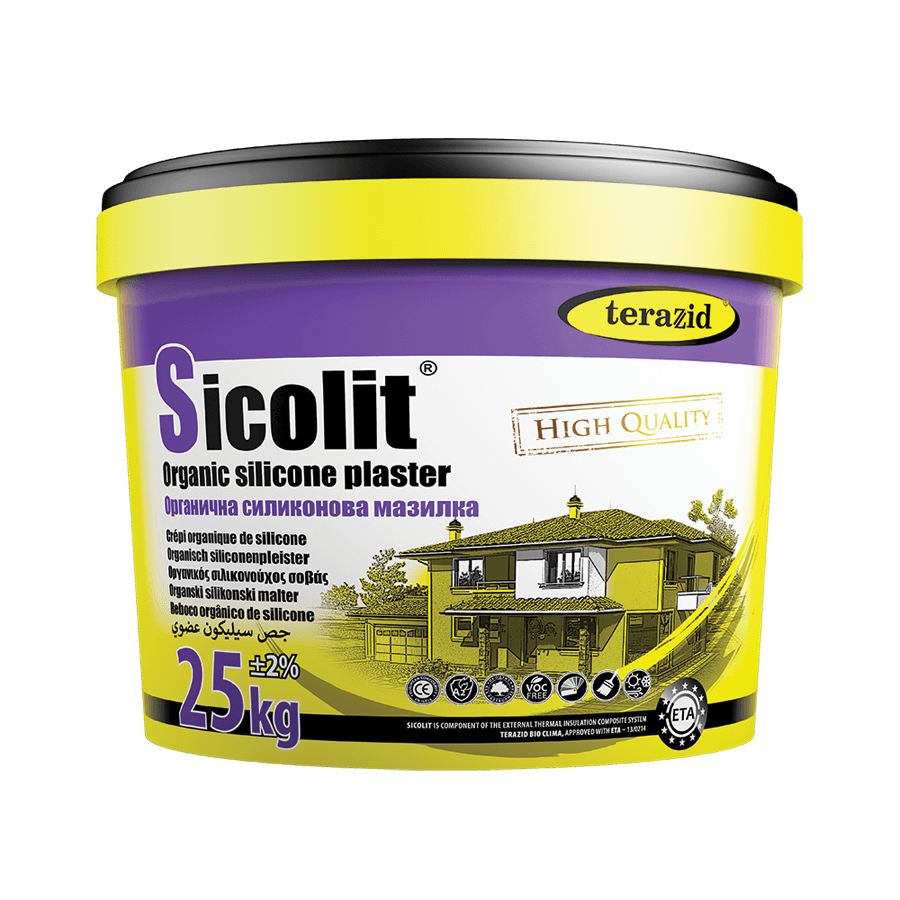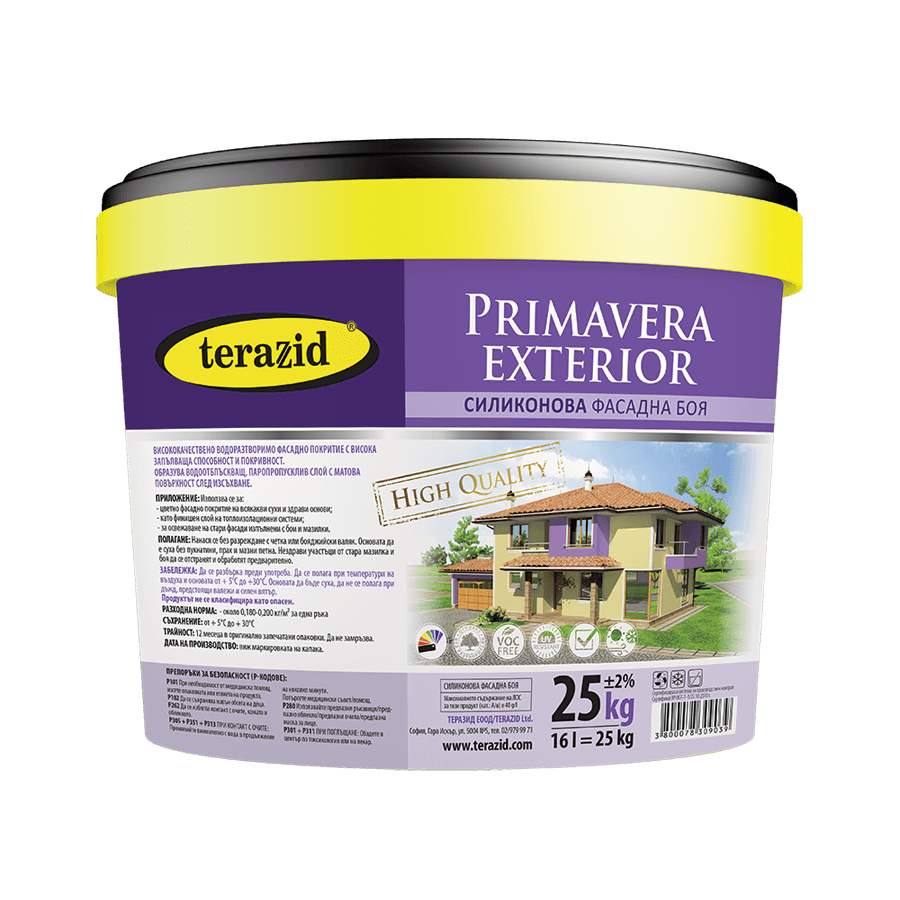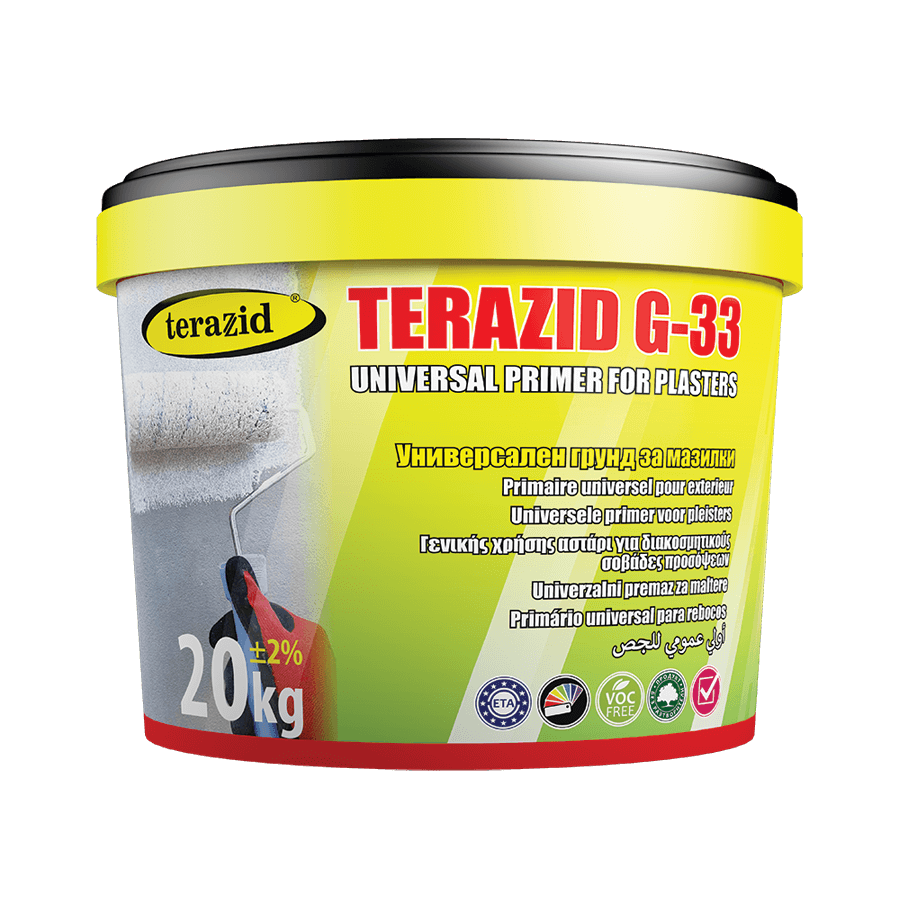WAT 500 – hydrophobic mixture for bonding and plastering of mineral wool
According to EN 13500:2004
Cement-based hydrophobic mixture for bonding and plastering of mineral wool thermal insulation boards
Category: Products for therm-insulation systems
Description:
PURPOSE
WAT 500 is a cement-based adhesive and base-coat plaster, with added fine mineral filters, reinforced mono fibres and polymer additives. It is designed for bonding mineral wool boards on walls and ceilings, in performing inner and external insulation of buildings. The material is suitable for building new walls, as well as for renovation of old buildings.
Implementation of protective reinforcement base-coat with WAT 500 prevents the insulation boards from “aging” and from the influence of the weather. The product ensures waterproofing and crack resistance of the finished layer and at the same time it protects the insulation layer from mechanical injuries. It creates an excellent basis for decorative finishing of the facades with the high-quality silicone plaster SICOLIT.
Declaration of Product Characteristics
WAT 500 – hydrophobic mixture for bonding and plastering of mineral wool
Declaration of Product Characteristics
DECLARATION OF PRODUCT CHARACTERISTICS
According with Regulation (BG) RD-02-20-1/2015
WAT 500
№ 20191114-01-D
1. Unique identification code of product type:
WAT 500
2. National requirements (Minister of Regional Development and Public Works, national regulation) technical specification (national standard, Bulgarian technical approval) applicable to the construction product:
BDS EN 13500 – Thermal insulation products for buildings — External thermal insulation composite systems (ETICS) based on mineral wool — Specification
3. Intended use or uses of the construction product in accordance with the national requirements, as foreseen by the manufacturer:
Cement-based mixture for bonding and plastering of mineral wool thermal insulation boards
4. Name, registered trade name or registered trade mark and contact address of the manufacturer:
TERAZID Ltd.
5 „5004” Str., Gara Iskar, Sofia 1528, Bulgaria
Tel.: +359 2 979 9971
E-mail: office@terazid.com
5. Where applicable, name and contact address of the authorised representative:
Not applicable.
6. Where applicable, name and contact address of the notified body to assess compliance with national requirements:
2032 – Building Research Institute (NISI), Sofia, Bulgaria
Test protocol № 953/14.11.2019
7. Declared performance:
| Characteristics | Performance | Test method |
|---|---|---|
| Reaction to fire | Class A1 | BDS EN 13820 |
| Bond strength with concrete base | 1430 kPa | BDS EN 1015-12 |
| Bond strength with MW slab (adhesive) | 90 kPa | BDS EN 13494 |
| Bond strength with MW slab (reinforced base coat) | 340 kPa | BDS EN 13494 |
| Compressive strength | 7.45 N/mm² class CS IV |
BDS EN 1015-11 |
| Flexural strength | 3.2 N/mm² | BDS EN 1015-11 |
| Coefficient of capillary absorption of water | 0.12 kg/m²·min0.5 class W2 |
BDS EN 1062-3 |
| Heat transmission λ10,DRY | 0.45 W/m·K | BDS EN 1745 |
8. The characteristics of the product identified in point 1 are in conformity with the declared performance in point 7.
This declaration of performance is issued under the sole responsibility of the manufacturer identified in point 4, or the authorised representative identified in point 5
Technical Data Sheet (TDS)
WAT 500 – hydrophobic mixture for bonding and plastering of mineral wool
Technical Data Sheet (TDS)
TECHNICAL DATA SHEET
WAT 500
Adhesive and Reinforcement Base-Coat Plaster for Insulation Boards
Cement-based hydrophobic mixture for bonding and plastering of mineral wool thermal insulation boards
PURPOSE
WAT 500 is a cement-based adhesive and base-coat plaster with added fine mineral fillers, reinforced mono fibres, and polymer additives. It is designed for bonding mineral wool boards on walls and ceilings during the construction of new buildings as well as the renovation of old ones.
The application of a protective reinforcement base-coat with WAT 500 prevents insulation boards from “aging” and protects them from weather conditions. The product ensures waterproofing and crack resistance of the finished layer, while also safeguarding the insulation layer against mechanical damage.
It creates an excellent basis for decorative facade finishes with high-quality silicone plaster such as SICOLIT.
PROPERTIES
-
Easy to apply
-
Sufficient open time (for work)
-
Cold resistant
-
Impact resistant (with a 3 mm thickness of the layer)
-
Vapour-permeable
PREPARATION OF THE BASE
WAT 500 has excellent adhesion to various construction surfaces, such as bricks, concrete, plasters, cement, and gypsum base-coats.
The base must be dry, well-cleaned, and strong.
Application over oil (grease) stains, dust, and other contaminants is not allowed. Old unstable plasters and other coatings must be removed.
Bases with high absorption, such as aerated concrete or gypsum blocks, should be primed in advance with deeply penetrating primer TERAZID G-55.
CHARACTERISTICS AND TECHNICAL DATA
-
Colour: Grey
-
Base: Cement
-
Density: 1.4 kg/l
-
Work temperature: +5°C to +30°C
-
Time for “maturing”: 10 minutes
-
Time for bucket stay: About 3 hours
-
Open time (for work): 30 minutes
-
Time for final bonding and subsequent operations: 14 days
-
Recommended thickness of the base coat layer: 3 mm
APPLICATION AND PROCESSING
For the complete dissolution of 25 kg of WAT 500, around 6.5 litres of water are required.
In a pre-prepared container with water, the necessary amount of dry mixture is poured and stirred using a mechanical mixer until a homogeneous mass is achieved. The stirred mixture should be left to mature for 8–10 minutes, then stirred once again before use.
Bonding:
-
On smooth and flat surfaces, the prepared solution is applied resembling a comb using a notched mortar-board with edge sizes of 8–10 mm.
-
On rough surfaces, the solution is applied around the entire outer rim of the insulation panel in a strip 4–5 cm wide, with additional “pillows” of adhesive placed in several spots in the center area of the panel.
Note: Additional fixing of the insulation with anchors can begin no earlier than 3 days after bonding (at temperatures not lower than 20°C).
PLASTERING
After the boards are anchored, WAT 500 can be used as a base-coat.
The solution is prepared in the same way and is uniformly applied. After that, the reinforcement fiberglass mesh is applied vertically, tightly pressed, and smoothed using a mortar-board.
The recommended thickness of the base-coat layer is 3 mm.
CONSUMPTION
-
Bonding: 5–5.5 kg/m², depending on the base
-
Reinforcing: 4 kg/m²
TOOLS FOR WORK
-
Bucket
-
Electrical drill and stirrer
-
Trowel
-
Mortar-board
-
Lute
WEATHER CONDITIONS AT WORK
The minimum 24-hour temperature of the air and the base should not be lower than +5°C, and the maximum should not be higher than +30°C.
It is not recommended to apply WAT 500 when the air humidity is high, if rain is forecasted, or during rainfall.
FORM OF DELIVERY
-
Dry mixture in paper packages of 25 kg
NOTES
-
Characteristics and technical data presented in this Technical Data Sheet are defined at a standard temperature of 20°C and a relative humidity of 50%.
In other weather conditions, the technological times for some of the processes mentioned above could be shorter or longer. -
The product information is based on the practical experience of the manufacturer and technical tests performed in specialized laboratories.
-
Do not add cement, sand, or other materials to the product, as this will deteriorate its quality.
-
All hazard and precautionary statements regarding WAT 500 can be found in the product’s Safety Data Sheet.
STORAGE
-
Shelf life: 12 months in the originally sealed packages
-
Storage conditions: Store in a dry and ventilated area. It is recommended to store the product on pallets.
| TERAZID Ltd. | ||
| 5 “5004” Str. Gara Iskar, Sofia, Bulgaria | ||
| NB 2032 | ||
| DoP № 2019114-01-D | ||
| WAT 500 | ||
| Adhesive and reinforcement base-coat plaster for mineral wool insulation boards |
||
| Reaction to fire | A1 | |
| Bond strength with concrete base | 1430 kPa | |
| Bond strength with MW slab (adhesive) | 90 kPa | |
| Bond strength with MW slab (reinforced base coat) | 340 kPa | |
| Compressive strength | 7.45 N/mm² class CS IV |
|
| Flexural strength | 3.2 N/mm² | |
| Coefficient of capillary absorption of water – c | 0.12 kg/m²·min0.5 class W2 |
|
| Heat transmission λ10,DRY | 0.45 W/m·K | |
The manufacturer recommends checking the suitability of the product in the Technical Data Sheet. The same is responsible for the product quality, but not for the ways and conditions of its applying. The information into the present Technical Data Sheet is reliable but only if the product is used under stated conditions. The responsibility of any other usage of the product, including its usage in a combination with any other product or a process, is borne by the user.
Material Safety Data Sheet (MSDS)
WAT 500 – hydrophobic mixture for bonding and plastering of mineral wool
Material Safety Data Sheet (MSDS)
MATERIAL SAFETY DATA SHEET
According to (EU) 830/2015
WAT 500
1. Identification of the Substance/Mixture and of the Company
1.1. Product identifier – WAT 500 1.2. Application of the substance Cement-based mixture for bonding and reinforcing of insulation boards 1.3. Details of the supplier of the safety data sheet TERAZID Ltd. 5, 5004 Street, Gara Iskar1528 Sofia, Bulgaria tel. +359 2 9799971, office@terazid.com 1.4. Emergency telephone number (EU) 112 UMHATEM “Pirogov” (toxicology) – +3592/9154409; +3592/9154233
2. Hazards Identification
2.1. Classification of the substance or mixture – Classification in accordance with Regulation (ЕО) 1272/2008 – CLP: The product is classified as „dangerous“. 2.2. Label elements Hazard pictograms:
 Signal word: Danger!
Signal word: Danger!
Hazard statements: H315 – Causes skin irritation. H318 – Causes serious eye damage. H335 – May cause respiratory irritation. Precautionary statements: P101 – If medical advice is needed, have product container or label at hand. P102 – Keep out of reach of children. P261 – Avoid breathing dust/fume/gas/mist/vapours/spray. P280 – Wear protective gloves/protective clothing/eye protection/face protection. P302 + P352 – IF ON SKIN: Wash with plenty of soap and water. P332 + P313 – If skin irritation occurs: Get medical advice/attention. P305 + P351 + P315 – IF IN EYES: Rinse cautiously with water for several minutes. Get immediate medical advice/attention. P402 – Store in a dry place.
2.3. Other hazards Contains portland cement. When reacting with water, it creates an alkaline medium. Does not contain soluble Cr (VI) into a quantity greater than 0,0002 % within the period of storage. For all warnings and recommendations, see Section 15. 3. Composition/information on ingredients General chemical description: Adhesive and base-coat plaster on the basis of portland cement, mineral fillers and modifying additives. Information of the substances in accordance with CLP 1272/2008/EC
| CAS № EINECS № |
Name | Concentration (%) | Signal word | H-codes |
|---|---|---|---|---|
| 65997-15-1 266-043-4 |
Grey cement | 20–40 | Hazardous | H315, H318, H335 |
All warnings can be seen in Section 15
4. First Aid Measures
4.1. Description of the first aid measures Inhalation – Remove the person to fresh air. If the symptoms continue, immediately seek for qualified medical help. Skin contact – Immediately rinse the area of the contact with plenty of water, then wash it thoroughly with soap and water. Eye contact – Irrigate with plenty of water for a period of at least 15 minutes and open eyelid. Seek for qualified medical help. Ingestion – Do NOT induce vomiting. Seek for qualified medical help. 4.2. Most important symptoms and effects, both acute and delayed In contact with the eyes: irritation. In contact with the skin: redness, inflammation. 4.3. Indication of any immediate medical attention and special treatment needed – see p. 4.1.
5. Firefighting Measures
WAT 500 is non-combustible and non-explosive product. 5.1. Extinguishing media Water mist, water spray – sprayer, dry chemical, foam, carbon dioxide. Inappropriate means for extinguishing fire – Not known. 5.2. Special hazards, arising from the substance or mixture – Non known 5.3. Advice for firefighters: Autonomous respiratory equipment.
6. Accidental Release Measures
6.1. Personal precautions, protective equipment and emergency procedures Gloves, masks, protective clothing for work. Contact with skin and eyes should be avoided. 6.2. Environmental precautions Prevent this product from release in the environment. Measures should be taken for preventing contamination of surface and underground watercourses, soil, as well as falling into the drains. In the event of an accident and/or spill of the product, measures for localization and limitation should be taken, and the collected amount of the product should be temporarily stored into a special, tightly closed and labeled containers, and after that they should be transferred to people, holding permits under the Article 37 of the Waste Management Act. 6.3. Methods and materials for containment and cleaning up The spilled amount should be mechanically removed, by taking measure to prevent formation of high concentration of dust in the air. The amount in the form of dust or unhardened mixture should be rinses with water and soap. Collected amount should be stored in special, tightly closed and labeled containers and to be temporarily stored on the territory of the company, and after that they should be transferred to people, holding a permit under the Waste Management Act (WMA).
7. Handling and Storage
7.1. Precautions for safe handling The product should be used only according to its main purpose. Do not eat, drink or smoke during work. Avoid formation of dust and often ventilate the room. Avoid skin and eye contact. 7.2. Conditions for safe storage, including any incompatibilities It should be stored in ventilated and dry places, into the originally sealed pakcages. Temperatures lower than 0C and higher than +50C should be avoided. It should be separately stored from food and drinks. 7.3. Specific Usage There is no specific usage. It should be used only according to its main purpose.
8. Exposure Controls/Personal Protection
8.1. Control parameters Portland cement – permitted level of inhaled powder particles: 5 ppm/5 mg/m³ air/. 8.2. Exposure controls 8.2.1. Respiratory protection – use a mask preventing from inhaling dust, filter P2. 8.2.2. Skin protection – skin contact should be avoided, wear protective gloves. 8.2.3. Eye protection – eye contact should be avoided, wear safety glasses. 8.2.4. Common protection – it should be stored away from food, drinks and food for animals.
9. Physical and Chemical Properties
9.1. Information on basic physical and chemical properties
-
Appearance: Fine powder
-
Color: Grey
-
Odor: None
-
pH at 20°C: Approximately 8.0
-
Solubility: Insoluble
-
Explosive properties: Non-explosive
9.2. Other information – no data.
10. Stability and reactivity
10.1. Reactivity – the product reacts with the moisture and gets hardened. 10.2. Chemical stability – the product is stable under storage and usage in accordance with the indications. 10.3. Possibility of hazardous reactions – in accordance with section 10.1. 10.4. Conditions to avoid – it should be kept away from moisture at storage and transportation. 10.5. Incompatible materials – no data.
11. Toxicological Information
11.1. Information for the toxicological effects Toxicological properties of the product are not tested. The product is classified under the conventional method in accordance with Regulation (ЕО) 1272/2008 – CLP. On the basis of its composition, the product can be defined as not having any toxic effects under a proper usage. The product is not hazardous of acute poisoning. Ingestion – It is less likely that the ingestion will lead to reaction or long-term effect, but is recommended to be avoided. Inhalation – Dust can cause irritation in the nose, the throat and the lungs, leading to coughing. Skin contact – In combination with heat and sweat, the product can cause irritation, but is not absorbed through the skin. Eye contact – The product can cause serious eye damage.
12. Ecological Information
12.1. Toxicity It is not expected that the product is hazardous for the environment (LC50 toxicity in water – it is not defined). Adding large amounts of water, however, can lead to rising of pH and therefore it can appear to be toxic to aquatic organisms at certain conditions. 12.2. Persistence and degradability – No data. 12.3. Bio-accumulative potential – Low potential of bioaccumulation. 12.4. Mobility in soil Hard product with non-organic origin. 12.5. Results of PBT and vPvB assessment – the product does not meet the criteria of PBT (persistent, bioaccumulative and toxic) and vPvB (very persistent and very bio-accumulative). 12.6. Other adverse effects No data.
13. Disposal Considerations Product waste, such as residual quantities and packages, should be collected into a special, tightly sealed and labeled containers, temporarily stored, and after that to be transferred to people, holding a permit in accordance with article 37 of the Waste Management Act (publication SG, issue 53, 2012). Waste code, in accordance with Regulation №2 from 23.07.2014 for Waste Classification: 10 13 – Waste from the production of cement, lime, gypsum and items and products, made of these materials. 10 13 14 – Waste concrete and concrete sediment. 15 01 – Packages. 15 01 10 – Packages, containing residues of hazardous substances or contaminated with hazardous substances. Completely empty the packages and dispose them in accordance with the local regulations– at the indicated places for paper waste.
14. Transport Information
It is not a hazardous load, in accordance with RID, ADR, ADNR, IMDG, IATA-DGR. It should be transported under the respective rules for transportation, concerning the respective type of transport and ensuring the safety of the load.
15. Regulatory information
15.1 Classification and labeling of the product in accordance with Regulation (ЕО) 1272/2008 – CLP /full text of the codes/
GHS Pictograms:
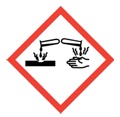 GHS05
GHS05
 GHS07
GHS07
Signal word: Danger! GHS07 Recommendations for danger (N – codes): None. Hazard statements (H – codes): H315 – Causes skin irritation. H318 – Causes serious eye damage. H335 – May cause respiratory irritation. Precautionary statements (P – codes): P101 – If medical advice is needed, have product container or label at hand. P102 – Keep out of reach of children. P261 – Avoid breathing dust/fume/gas/mist/vapours/spray. P280 – Wear protective gloves/protective clothing/eye protection/face protection. P302 + P352 – IF ON SKIN: Wash with plenty of soap and water. P332 + P313 – If skin irritation occurs: Get medical advice/attention. P305 + P351 + P315 – IF IN EYES: Rinse cautiously with water for several minutes. Get immediate medical advice/attention. P402 – Store in a dry place.
15.2. LEGISLATION
National Legislation:
-
Law of Protection from the Harmful Impact of the Chemical Substances and Preparations
-
Environmental Protection Law
-
Health and Safety at Work Act
-
Ordinance №3 on the Minimum Requirements for Safety and Protection of Workers When Using Personal Protective Equipment at the Workplace
-
Waste Management Act
-
Ordinance №2 from 23.07.2014 for Waste Classification
-
Ordinance on the Order and Method of Classification, Labeling, and Packaging of Chemical Substances and Preparations
European Legislation:
-
Regulation (EC) 1272/2008 – CLP from 16th December 2008, concerning the classification, labelling, and packaging of substances and preparations
-
Regulation (EU) 830/2015 from 28th May 2015
16. Other Informaiton
16.1. Indication of changes Format in accordance with Regulation (ЕО) 830/2015 from 28th May 2015 amending Regulation № 1907/2006 (REACH) of the European Parliament. 16.2. Training advice In addition to the training programs on environment and health and safety of the workers, the companies need to be sure that their workers read, understand and apply the requirements of the MSDS. 16.3. Additional information See the application(s) of exposure scenarios for the following substances: The basic information of the exposure scenarios of the substances in the mixture are included in points 1, 2, 3, 8, 11 and 12.
16.4. Disclaimer
This safety data sheet and the data inside of it are based on industrial and commercial experience of many years and are fully complied with the current active legislation of the Republic of Bulgaria and the European Union. This safety data sheet is not intended to guarantee any specific properties and qualities of the product. The information inside of it is reliable but, on the circumstance, that the product is used in accordance with the indicated conditions and the application, specified on the package and/or in the technical literature. Responsibility of any other use of the product, including when using it in combination with another product or process is completely under the responsibility of the user. It is understood that the user is responsible for defining the appropriate precautions and for applying the legislation, concerning his own activity.
Technical Data
| Time for bucket stay | around 3 h. |
| Open time for work | 30 min. (at 20°С) |
| Ready for following operations | 14 days |
| Thickness of applying of the plaster | minimum 3 mm |
| Consumption | bonding 5-5.5 kg/m²; plastering: 3.5-4 kg/m² |
| Package | 25 kg (gray) |
| Price | see price list |
| Pieces | 48 pcs/pallet |
Related Products
Facade finishing coats and paints
Facade finishing coats and paints
Primers and impregnators
Additives for concrete
